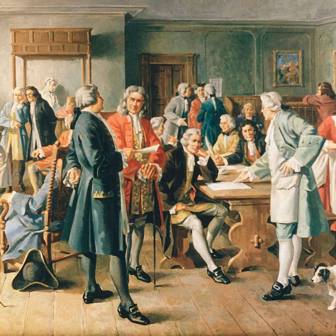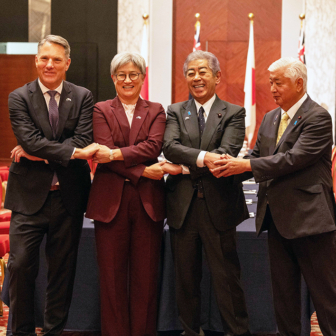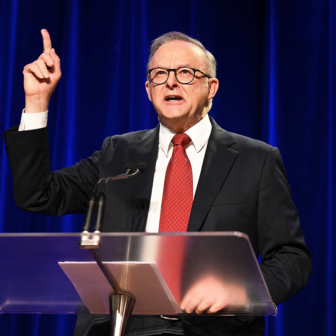Four months ago the Liberal Party of Canada looked headed for disaster. After nine years in government, the party was regularly polling below 20 per cent, with the opposing Conservatives consistently well above 40 per cent, a guarantee of a majority in Canadian politics. Some polls found the minor New Democratic Party surpassing the Liberals and the geographically concentrated Bloc Quebecois also on track to win more seats than the governing party. And yet prime minister and Liberal leader Justin Trudeau refused to step down, seemingly determined to lead the party into the next election and possibly into oblivion.
What a change. As election day looms on 28 April, Trudeau is gone and the Liberals are the frontrunners, cresting 40 per cent with victory in sight. Conservative support has only modestly sagged, but is stuck in the high 30s. NDP support has been halved to less than 10 per cent and the Bloc Quebecois has also declined. Seat projections are volatile, but all indicators are that the Liberals will be re-elected to a fourth term and possibly an outright majority.
Who is responsible for this miraculous turnaround? Step forward, Donald Trump.
While it may not have been his intention, Trump’s aggressive tariff policies toward Canada, now expanded to the rest of the world, and his constant musings about making Canada the fifty-first state, precipitated a revolution in Canadian politics. This existential threat managed to finally dislodge the no longer popular Trudeau from office and reframe Canadian politics away from the Liberals’ mixed governing record to the simple ballot question of who is best able to take on Donald Trump.
Rarely has a Canadian election been less about issues and more about the vague concept of “leadership.” The parties won’t release their full platforms until just days before the vote, and there has been little discussion of significant policy differences. Instead, the prevailing issue is Trump. While the two major parties and their leaders disagree somewhat in their approach to the tariff threat, the incoherence and erraticism of Trump’s policies make even those differences insignificant. Instead, Trump is a valence issue — one in which there is a broad consensus on direction, with the only question being who is most-suited to lead the way.
The winner of that reframing is Liberal leader and prime minister Mark Carney, Canada’s newest politician and the beneficiary of remarkable luck and timing. The great loser is Conservative leader Pierre Poilievre, who seemed destined for the prime ministership until Trump flipped the script.
Let’s start with the lucky Mark Carney. Born and raised in western Canada, Carney left the country at the age of nineteen to attend Harvard before moving on to Oxford for a doctorate in economics. He then spent thirteen years at Goldman Sachs, with postings in London, Tokyo, New York and Toronto. He left the private sector in 2003 for a position at the central Bank of Canada in Ottawa, later moving to a senior role in the Department of Finance. In 2008 he took the top post at the Bank as its governor, just in time to face the global financial crisis.
Carney’s work in the crisis was widely praised; he was seen as a cool-headed pragmatist putting his golden resumé to good use. After a five-year term with the Bank of Canada he moved to Britain and took the same position as governor of the Bank of England. Once again, he found himself on duty as a crisis emerged: this time Brexit. While sceptical of the Leave case, he again gathered wide respect as a competent pragmatist steering through economic turmoil amid enormous political and market pressure.
Carney finished his term and returned to Canada in 2020. His choice to again live in Ottawa rather than the financial capital of Toronto was an obvious clue that his ambitions remained in the public rather than private sector. He had long been identified as a candidate for public office, and for more than one party. He was reportedly courted in 2012 by Conservative prime minister Stephen Harper to join his cabinet, though details are murky.
What is undisputed is that Liberal officials made a serious effort in 2013 to encourage Carney to stand for the vacant party leadership; Carney declined the invitation, though he left enough clues to suggest the idea was not out of the question. That race was won by Justin Trudeau, who brought the party to a glorious 2015 victory but then slid to minorities in 2019 and 2021 and even deeper unpopularity, and atrocious polling figures, in 2024.
Carney continued to flirt with politics, never quite taking the plunge. He dabbled in the private sector, becoming vice-chairman of Toronto-based investment conglomerate Brookfield, a board member for global fintech Stripe and, later, chair of Bloomberg. He leaned into environmental causes, organising global conferences, forming taskforces and writing a book. He also finally declared his party loyalties, appearing at a Liberal convention in early 2021.
Yet he remained evasive. He didn’t run in the 2021 election, an obvious point to join the team, and his public activities remained more policy-dense than openly partisan. As the Liberals under Trudeau slid in the polls, Carney’s reticence to join a sinking ship became almost comical.
Meanwhile, Trudeau’s own position became less and less tenable. The party’s terrible polling was accompanied by disastrous by-election losses of formerly safe Liberal seats in Toronto and Montreal. Yet Trudeau gave no sign of leaving, and was protected by his party’s longstanding barriers against leadership challenges. Anti-Trudeau insurrection was limited to a few caucus gadflies and underground rumours.
The Liberal position weakened further in September 2024 when the NDP abandoned the confidence-and-supply agreement that had propped up Trudeau and his colleagues since 2022. Throughout late 2024 the Conservatives repeatedly triggered non-confidence votes to bring down the government, which was saved only by last minute deals with the NDP and/or the Bloc, who had their own fears of being buried in a Conservative landslide.
But then came Trump’s second win. The US president-elect blew up Canadian politics in November by declaring his plan for 25 per cent tariffs on America’s two closest neighbours. While in hindsight it was merely a foretaste of the global disruption to come, the pledge immediately dominated Canadian politics. Trump then doubled down with musings that Canada would be better off as the fifty-first state, reigniting two hundred years of national paranoia about American annexation.
Canada went into crisis mode, and Carney was a possibly inadvertent player in the moment of truth. On 13 December, Trudeau told his finance minister Chrystia Freeland that he was moving her to a new but vague portfolio of Canada–US relations to deal with the Trump crisis, and that her finance job would go to Carney. The incensed Freeland quit three days later, citing disagreements with Trudeau’s entire strategy and bringing an emergency cabinet shuffle a few days later. Many expected Carney to show up that day, but he did not, and it remains unclear if he even knew of Trudeau’s plan. Over Christmas, speculation grew that a Trudeau resignation was finally coming, yet it was still not clear where Carney would fit.
Things quickly fell into place once Trudeau resigned on 6 January. Carney declared his candidacy and most party figures — except for ex-minister Freeland and two others — stepped aside. Despite his lack of a parliamentary seat, he quickly became the frontrunner, his global resumé and experience seemingly tailor-made for the Trump challenge. He romped to victory on 9 March with 85 per cent of the membership vote and was sworn in as prime minister on 14 March. Then, not much more than a week later, he called an election for 28 April. Liberal poll support, rising since Trudeau’s resignation, surpassed the Conservatives in early March and has stayed there since. After years of reticence, the stars had aligned and Carney’s magic moment had arrived.
If Carney has had a very lucky 2025 so far, his opponent Pierre Poilievre has had a nightmare. Once looking destined for a triumphant majority, he is increasingly likely to finish in second place. Like other right-wing politicians inside and outside the United States, Poilievre has learned that being seen as close to Donald Trump, who only tolerates sycophants, not mere allies, can be politically dangerous. Trump has wrecked Poilievre’s plan to fight an election on the Liberal record and forced him to spend valuable energy articulating his own patriotism and distance from Trump.
The Conservative leader increasingly looks purpose-built to deal with yesterday’s challenge: taking down Justin Trudeau. In parliament since 2004, when he was twenty-five, he built a steady career as the Conservative attack dog, skewering Liberals while building presence and loyalty in the party. As party leader from 2022 he cruised the country buoyed by a feeling of inevitability and equipped with a twenty-first century conservative platform that emphasised cost-of-living and housing affordability and targeted Trudeau’s elitist progressivism with a promise of populist disruption. He has taken particular aim at the carbon tax, a complicated carbon-pricing regime that is sound economics but led to higher prices at the gas pump. Party fundraising was through the roof, and Poilievre was a master of slogans, with “Canada is Broken” and “Axe the Tax; Build the Homes; Fix the Budget; Stop the Crime.”
But then Justin Trudeau had suddenly gone and the ballot question changed. The Trump threat ignited a swell of national pride that overwhelmed any sense of brokenness; flags proliferated and shoppers avoided American products. Toronto-born comedian Mike Myers, best known for his 1990s performances in Wayne’s World and Austin Powers, International Man of Mystery and as the voice of Shrek, inspired a national “Elbows Up” campaign, a term from ice hockey that indicates a readiness to defend and fight.
Poilievre, who spent only a short time as a minister in the Harper government and whose only experience outside politics is the short internship at a manufacturer he won as part of a “If I Was Prime Minister” essay contest, seemed far less qualified to take on Trump than did the global finance expert who steered through the GFC and Brexit. Despite a much more disciplined and rational style than the American president, his reliance on populist anger placed him uncomfortably close to Trump-style politics, and the chaos in Washington drove Canadians to seek continuity rather than disruption. As a final blow, Carney’s first act as prime minister was to pause the carbon tax, robbing Poilievre of his top issue.
Still, there was hope for the Conservatives as the election was called. Carney may have been the Bright New Thing, but history suggested the gloss would soon wear off. In both 1984 and 1993, unpopular prime ministers were replaced by newcomers who briefly shone in the polls but then collapsed in the election campaign and endured humiliating defeats.
And those two leaders had been experienced parliamentarians, while Carney was a newcomer to partisan politics. He struggled at times in the new role, snapping impatiently at an interviewer and displaying occasional clumsiness as a newcomer starting at the top. He had to explain why his former company Brookfield had relocated its head office from Toronto to New York, and evaded questions about his private wealth, which he had placed in a blind trust but did not disclose or sell. His Oxford doctoral thesis was dug up and found to have numerous minor plagiarisms, at best a sign of sloppiness. Most of all, his command of French, essential for success in national Canadian politics, was limited and sparser than his opponents’, raising questions of his viability among Quebec voters.
Carney did shoot himself in the foot early, defending a Liberal MP of Chinese background who had remarked that his Conservative opponent, also Chinese-Canadian and under indictment in Hong Kong for political activities, should be turned over to Chinese authorities for a bounty. Carney accepted an apology from his MP and defended him for several days until the MP resigned as a candidate, only to be replaced by another candidate with possible ties to the Chinese government.
Liberal operatives were also found to have made and circulated “Stop the Steal” buttons at a Conservative policy event in an attempt to tie the Conservatives to Trump-style election denial. (Poilievre immediately affirmed that he would accept the election results.) Carney apologised for the error but merely said the staffers had been “reassigned.”
Yet missteps like this didn’t detract from Liberal momentum, and the shameless glee and opportunism of the Liberal turnaround became hard to miss. Nova Scotia’s Sean Fraser, who had resigned from cabinet and politics at the Liberal low point in December (to spend more time with his family, he claimed) suddenly reversed his plans, saying he had a heartfelt conversation with Carney who had promised him more family-friendly hours. Industry minister Anita Anand and other once-departing Liberals similarly decided that politics wasn’t so bad after all. Carney and comedian Myers filmed a lighthearted “Elbows Up” commercial together. Depression and a sense of inevitability were replaced with zest and the excitement of sweet comeback.
In turn, Conservatives are turning their guns on each other. Poilievre and his campaign manager Jenni Bryne, a legend in party circles for her tough partisanship, seem determined to stick to their original strategy of focusing on the Liberal record, tapping into the fears and grievances that had sustained them for so long, rather than pivoting to engage wholesale with the Trump question. The internal grumbling broke wide open with stunning public remarks by another prominent Tory campaigner, Kory Teneycke, who oversaw the re-election of Ontario premier Doug Ford in February with an explicit “Protect Ontario” platform. Teneycke accused his federal counterparts of “campaign malpractice” and repeatedly criticised the failure to pivot; Ford later echoed his campaign manager, saying “the truth hurts.”
But it is also true that Conservative support has only dropped slightly since Christmas and Poilievre’s message continues to resonate with many. The key problem is that non-Tory voters are all huddling behind Carney. While the Conservatives see victory slipping from their grasp, things are even worse for the New Democratic Party, and even more bittersweet.
Since the 1960s, the NDP has consistently expressed the most wariness of the United States, opposing free-trade agreements and the integration of the Canadian and US economies — the very arrangements that make Trump’s threats so existential. But its support has collapsed, siphoned off by the Liberals as frightened progressives turn to centrist Carney as their best hope against Trump and what they see as the Trump-lite Poilievre.
Even former leader Tom Mulcair, deposed from his post in 2016, urged voters not to waste their vote on the NDP. Projections now suggest support will fall below the minimum twelve seats needed for party status in the House of Commons and leader Jagmeet Singh, who has delivered mediocre results since 2017, is unlikely to stay on.
A similar if less dire fate may await the Bloc Quebecois, which is likely to fall below its current thirty-three seats. Again Trump is to blame; while French-speaking Quebecers have long been sceptical of their place within Canada, the prospect of absorption by the United States is far more horrifying, leading to an unlikely but pragmatic embrace of Canadian nationalism that again benefits the Liberals despite Carney’s less than total fluency in French. Even the tiny Green Party, with its two seats, may be a casualty; traditionally a convenient catch-all for voters disillusioned with the major parties, it could be left behind in the rush to join Carney with elbows up.
The great hope of the Conservatives was the national party debates, held on 16 and 17 April in French and English. (In a refreshing sign of normalcy amid the Age of Trump, the time of the French debate was changed at the last minute to accommodate an important Montreal Canadians hockey game.) It was hoped that the inexperienced Carney would sag in French and make a game-changing flub against the tested and experienced Poilievre. But Carney acquitted himself well both nights, exuding a sense of maturity and cool judgement despite Poilievre’s repeated attempts to turn the focus to the Liberal record. At one point Carney turned to Poilievre and said “Mr Poilievre, you spent years running against Justin Trudeau and the carbon tax and they’re both gone.”
Election day is 28 April, and the only real question is whether the Liberals will win an outright majority. Any more Trump bombshells like White House press secretary Karoline Leavitt’s 15 April affirmation that Trump still favours annexation will likely only drive Canadians further into Carney’s arms. Poilievre is likely to fall short of his goal of the prime ministership, though his solid vote and immaculate credibility within the party is likely to preserve his leadership. But like other moderate right-wing leaders around the globe he will continue to struggle to position himself against a chaotic and self-centred president who does him no favours. Meanwhile, Mark Carney is well within reach of his dream job. Now he must fulfil the role on which the country has placed its hopes. He must take on Donald Trump, with elbows up. •




